Introduction
In view of the prevalent ergonomic museum Web sites and the numerous mediocre hypermedia applications in this field it seems that the applications that use a holistic approach to dramaturgy, navigation and design are the exception rather than the rule. To counteract the dominant 'visual cacophony', we need strategies that can best be circumscribed with the word 'decelaration', 'simplicity' and 'narration'. In the coming years this commitment to decelaration and simplicity will affect and change the way in which we design applications – Maeda already noted this in his "laws of simplicity" (http://lawsofsimplicity.com; Schoepf/Stocker 2006), so this is not a new idea. Those who wish to tell stories, will have to learn to listen first. This insight is a return to old virtues and has it's philosophical foundation in the theme of the "Festina Lente" (Hurry slowly). After Sueton's chronicle 'Life of Augustus' one of the favorite proverbs of this Roman imperator Erasmus of Rotterdam described in his 'Adagia' "Festina Lente" with every justification as a royal proverb, because of its use in all cases of life. This proverb combines the intial phase of careful deliberation (before a decision is made) with the efficiency of an action (after the decision). Applied to the design of hypermedia applications this means to weave "moments of contemplation" into the narrative flow in order to create a varied dramaturgy. The rules of design, particularly with regard to hypermedia, should be content-oriented. So navigation can become content in itself and create a "reflexive liquid information architecture" (Kraemer 2006).
Despite continual standardisation forced by the ergonomic rules of accessability and usability any new project still needs to define its own rules in accordance with the goals of said project.
In this interplay of dramaturgy and narration lie the challenges for navigation and overall design.
The numerous means of hypermedia-design allow an imaginative, innovative, inventive information-design, which is meant to be intuitive in its usage. How far the principle of "Festina Lente" will influence the design of hypermedia applications, will be demonstrated in the following pages with the help of a few examples.
Guidance System
In the same way that the rooms of an exhibition are part of a whole, parts of a CD ROM are also part of a homogeneous entireness. Thus the visitors, as well as the users, are also differenciated into groups of interested observers, playful discoverers and encyclopaedists deliberatly searching for information. This typology of user attitudes can also be applied to information architecture. The stroller prefers a networked structure, which can be navigated by assoctiation, those who prefer stories mainly want linear forms of interacive narration and those who are interested in the world of facts and figures prefer a hierarchical structure. This classification – Janet H. Murray (2000) called this "digital environments" – corresponds to the typology of Stephan Bode (1995, 340), who has differentiated the "multimedial informationssystems" into "play-oriented edutainment-applications with a high level of interaction", "a linear tree structure with only limited means of interaction" and a "hypertext-based system, allowing complex and independent enquiries". In many CD ROMs, navigation just serves as a guidance system leading the user to the database-structured content. Content, navigation as well as interface-design thus often drift apart. On the other hand there are examples where content, navigation and design can form a successful symbiosis.
Voyeurism
In one of the hypermedia classics, the CD ROM 'The Marguerite and Aimé Maeght Foundation, a stroll in xxth century art' (1995), the view presented to the visitor is that of a voyeur and forms an essential part of the navigation. This approach is a kind of window-shopping view to satisfy the visitors curiosity. The user is in the role of a discoverer, armed with a video camera, strolling around, discovering the artefacts in the garden. On the CD ROM 'Wanås. Contemporary Art in the Castle Woods of Wanås' (1998) this voyeuristic approach is visualized by the guiding assistance of a jogging avatar. The never idle runner is thus connecting the works of art. The user can take pictures of his/her favorite items and file them in an album like postcards. In comparison to the Maeght voyeur who is more of an onlooker, the Wanås voyeur is a kind of a paparazzi, documenting the favorite places he/she has seen. Maeght and Wanås are nice excursions, but 'Place-Hampi' (2006) is a masterpiece of panoramic or cycloramic voyeurism.
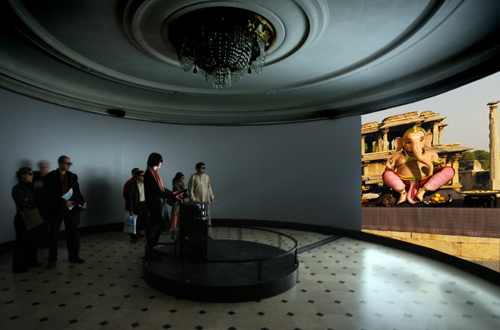 Fig.
1: The Indian God Ganesha on Place-Hampi – augmented
stereographic panoramas of the Vijayanagara, India, 2006. http://www.icinema.unsw.edu.au/projects/prj_hampi.html
Fig.
1: The Indian God Ganesha on Place-Hampi – augmented
stereographic panoramas of the Vijayanagara, India, 2006. http://www.icinema.unsw.edu.au/projects/prj_hampi.html
Sarah Kenderdine and Jeffrey Shaw have realized a stereographic 3-D trompe l'oeil view of the Vijayanagara (Hampi) in India. Viewers explore a virtual landscape of archaeological, historical and sacred locations enlivened by animated mythological Gods like Ganesha. The re-discovery of these sacred locations by following these virtual Gods allows the visitor to become an invisible observer and timetraveller. Furthermore even viewers who have no knowledge of Indian mythology, landscape or architecture are drawn into an euphoric fever facing the reality of 'Place-Hampi'. This marvellous 3-D application will serve as a blueprint for coming projects.
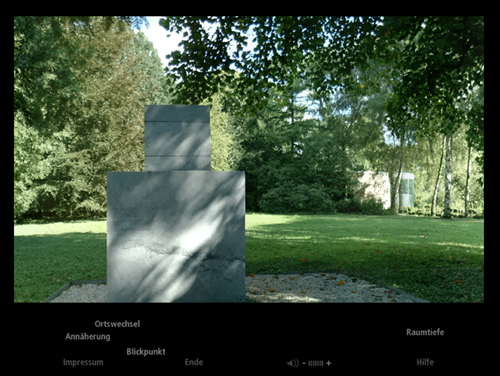 Fig.
2: A walk on the Museum Island of Hombroich on CD ROM 'Zwischenraum. Eine
Reise durch das Museum Insel Hombroich', Stiftung Insel Hombroich / ilumi – interaktive
erlebniswelten, 2002.
Fig.
2: A walk on the Museum Island of Hombroich on CD ROM 'Zwischenraum. Eine
Reise durch das Museum Insel Hombroich', Stiftung Insel Hombroich / ilumi – interaktive
erlebniswelten, 2002.
Compared to 'Place-Hampi' the journey through the CD ROM 'Museum Insel Hombroich' (2002) is a piece of landart. This marvellous journey offers silent spaces in the best sense of the word: gaping vistas, open sites and spaces of time. The interplay between nature, architecture and works of art creates a 'mantra' of continuous repetition. After following the path on the Museum Insel it seems that this rhythm stands in the tradition of Ralph Waldo Emerson's words:
Philosophically considered, the universe is composed of Nature and the Soul. Strictly speaking, therefore, all that is separate from us, all which Philosophy distinguishes as the NOT ME, that is, both nature and art, all other men and my own body, must be ranked under this name, NATURE. (Emerson 2006, 34).
So navigation and content are a means to an end in itself and the path the user has to walk is the goal. This unusual concept corresponds to the nature of this charismatic place and the experience of discovering the twelve pavilions and the works of art inside. But unfortunately the "experience ends with the experience". The user is deprived of obtaining more informations about the works of art. So the works by Arp, di Suvero, Graubner and Brancusi as well as sculptures of the Khmer still 'rest in peace'. At the end there remains a feeling of having missed something essential, and as such it feels incomplete.
Ludic Contents
Only a few applications allow for ludic association and experimental access of their content. Designed in the spirit of Media Art, these products often suffer from having too much interactivity. The user is not invited to stay and obtain informations, but is incited to stroll around endless. The sensual design streches from floating images to equally sensual sound and generates a feeling of 'hypermedia happiness'. It is not intended for the viewer to pause even for a moment. Everything flows and Heraclitus' bon mot of 'Panta Rhei' is the philosophy behind these applications. CD ROMs in this vein are 'Sigmund Freud. Archaeology of the Unconscious' (1999) produced by Nofrontiere and the Freud Museum in Vienna, or 'Build in the Light. The Glass House by Bruno Taut' (1996) (produced by mib Berlin) and have shown that the user is frequently not following a stringent logical way in the navigation but is jumping back and forth by the association he himself makes during his exploration. This approach is similar to a tentative search – remembering experiences and rediscovering them. The valency of each single item of information or fact is blurred into an entertaining monotony. This kind of CD ROM is only useful to the serious sciences in a very limited way, but it shows an excellent approach on how to handle and mediate knowledge, perception, authenticity and entertainement in our time.
Narrator
Different strategies in storytelling play a powerful part in the transfer of knowledge (Murray 1997; Marable 1999; Meadows 2006). By using a face-to-face, subjective and at least partly sentimental approach narrators can very effectively capture the attention the recipients. Many applications are using dramaturgies based on narrative concepts. Narrators can be persons, artefacts and events. This personalization contributes to an identification with the contents and the information. In the CD ROM 'William Forsythe. Improvisation Technologies. A Tool for the Analytical Dance Eye' (1999) by the ZKM Karlsruhe and Deutsches Tanzarchiv Cologne the famous choreographer is transformed from a dancer to a moderator of his own work. Forsythe documents his philosophy in the broader sense of the oral history, combining theory and practical experience by the charismatic presence of the original master – himself. All the cinematic tools of slow motion, filmstill, repetition, loop and reduction (Mikos 2003) have been used for just one reason: the analysis and teaching of the choreography by repetition. The DVD-ROM 'That's Kyogen' (2001) by Mansaku & Mansai Numora also uses this approach and applies it to the humorous world of the japanese Kyôgen theatre.
Dialogue
The strategy of conducting a conversation is a brilliant tool to explain complex topics and lead the user onwards by having him follow these conversations. The simple formula of asking a question and giving the answer is used in such different applications as the shopping expedition of a daughter and her mother strolling in the streets of Edo (Tokyo) on the CD ROM 'Kidai Shorân' (2000) or the conversation between grandpa Vitalis and granddaughter Artula on 'Augusta Treverorum Treveris. Discovering the Roman Trier!' (1998) or the fictional TV talk show 'Knowledge without limits' on the CD ROM 'Museum Schloss Kyburg' (2004). Here none other than the fictive Dr. Gugel (Google) himself has invited the famous historic Swiss encyclopedist Johann Jakob Leu to discuss the different methods of attaining knowledge in this work. Installed in the former workroom of the bailiff at Schloss Kyburg, the discussion takes up the controversial question: Do pupils still need a classical education considering the wealth of downloadable knowledge available on the Web?
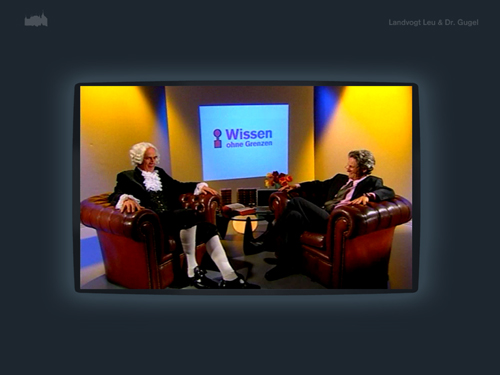 Fig. 3: The TV talk show 'Knowledge without limits'
with Swiss encyclopedist Johann Jakob Leu and Dr. Gugel on the CD ROM 'Museum
Schloss Kyburg', Verein Schloss Kyburg / Transfusionen, 2004.
Fig. 3: The TV talk show 'Knowledge without limits'
with Swiss encyclopedist Johann Jakob Leu and Dr. Gugel on the CD ROM 'Museum
Schloss Kyburg', Verein Schloss Kyburg / Transfusionen, 2004.
In a special competition the knowledge-based method of Leu's lexicon is competing against the search engine of Dr. Gugel. During the competition, the system simulates the search, analysis and creation of knowledge of three items: the Roman goddess 'Minerva', 'potato' and a special kind of Swiss toad named 'Geburtshelferkroete'. In the second part of the TV talk show Leu and Dr. Gugel are discussing the pros and cons:
Leu: "Searching facts is just one side, but to
generate new knowledge, you need a little bit more, Dr. Gugel. You can't
solely administrate the knowledge, you also have to practise and live it."
Dr. Gugel: "Quite true, my old friend, but in today's
world it's not necessary to know everything. It suffices that you
know where you can find the informations you're looking for, as these are
always available and searchable."
And by following Leu and Dr. Gugel the users learn that both systems of knowledge-based methods have their positive and negative aspects.
Linear Narrative
During the years 2002-2004 the project 'Virtual Transfer Musée Suisse' (http://www.virtualtransfer.com) was produced as a new vision of interaction and communication with the museum visitors (Kraemer/Jaggi 2003). All in all, around 30 stories are being told involving over 600 museum objects from eight different collections in five languages (German, French, Italian, Romansh and English). The artefacts thus become the narrators (Kraemer 2006): the 'chamber of marvels' e.g. is divided into 'masterpieces', 'favorite items' and 'curiosities'. These narrations can be an inner monologue spoken off-screen by a female voice reflecting on her mood examining an object (e.g. the Neolithic gynaecomorph container). Or an inner dialogue of the two halfs of a person discussing optimistic and pessimistic aspects of an item (e.g. Langobardic foil cross). By using the manifolded capabilities of an artefact, one of the messages can also be a political and critical statement – as it has been realized with 'The Blackamoor automaton' of 1646, as a historical clockwork a timeless masterpiece on one hand and a contemporary question of political correctness on the other.
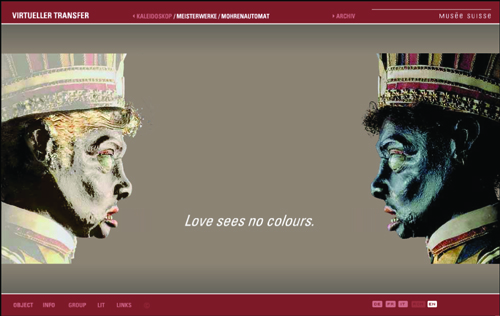 Fig. 4: From the chamber of marvels: The Blackamoor
automaton on 'Virtual Transfer Musée Suisse', Swiss National Museum
/ Transfusionen, 2002-2004, http://www.virtualtransfer.com.
Fig. 4: From the chamber of marvels: The Blackamoor
automaton on 'Virtual Transfer Musée Suisse', Swiss National Museum
/ Transfusionen, 2002-2004, http://www.virtualtransfer.com.
So Genette's (1998) insight that a narration tells less than it knows, but at the same time allows you to read between the lines and thus also communicates implied meaning, is also a viable approach to use in interactive storytelling. To separate the fiction from the correct historical facts and source material, the story has to be translated into the time of the narrator, the narrated time and the time of the narration. Otherwise authenticity becomes problematic as well as correctness of content. Ever present is also the danger of blurring the border between fact and fiction too much, thus compromising the original intent, i.e. to allow for a better understanding of said facts.
The Artefact As A Narrator
An interactive masterpiece of linear narration and scenic design is 'Kidai Shôran. Excellent View of Our Prosperous Age' (2000). The CD ROM gives an interactive overview of a 12m long hand scroll which shows a view of a shopping street in Edo (Tokyo) around the year 1805. The design and the navigation are both supporting the dramaturgy and the content of the scroll brilliantly. The CD ROM contains five different guided tours which offer different narrative perspectives of the scroll.
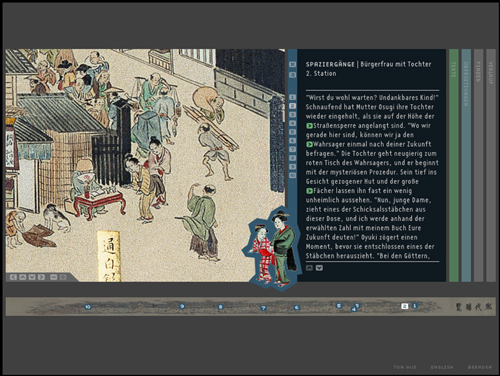 Fig. 5: A Japanese burgess with her daughter strolling
up and down the street on CD ROM 'Kidai Shôran. Excellent View of
Our Prosperous Age', Museum für Ostasiatische Kunst, Staatliche Museen
zu Berlin / Bureau Dr. Simmen, 2000.
Fig. 5: A Japanese burgess with her daughter strolling
up and down the street on CD ROM 'Kidai Shôran. Excellent View of
Our Prosperous Age', Museum für Ostasiatische Kunst, Staatliche Museen
zu Berlin / Bureau Dr. Simmen, 2000.
All in all this work offers a rather long longish promenade with it's own pacing and a lot that is left for the viewer to discover. Unfortunately the dialogues between the characters are only written and not spoken and there are rather too many hyperlinks which only lead to even more text. This means that the whole CD ROM contains a massive amount of text with unfortunately little else to break the flow, and thus ends up becoming a tiring experience to the viewer after a while. Spoken dialogues in the guided tours would have assisted the images and would have counterbalanced to wealth of text. Nevertheless 'Kidai Shorân' is an excellent example of how different strategies can support the different ways in which users approach this CD ROM.
Another example of a user-friendly application is the project 'Exploring Picasso's La Vie' by the Cleveland Museum of Art and Cognitive Applications. It shows the advantages of concentrating on one topic and illustrates a good relationship between the original work of art and an interactive multimedia installation. On the occasion of an exhibition the visitor finds himself not far from Picasso's original masterpiece La Vie (1903) and is presented with an interactive display of the same. The design of the interface is clearly arranged, the navigation plain and straight, furthermore the amount of information is manageable, so the viewer is not overwhelmed with information. Mies van der Rohe's "less is more" philosophy is used as its best. Where this CD ROM really excels is its presentation on the screen though – it is as simple as it is brilliant to turn a horizontal screen by 90 degree to get an upright screen. The images are all exceptionally large and nearly the size of the original, thus creating a permanent high level of attentiveness of the audience.
Complexity
In addition to these forms of interactive storytelling there are some complex narrations combining historical facts and artefacts to an exciting plot with different levels of depth. The virtual reconstruction of the exploration tour 1804-1806 along the Missouri River by Meriwether Lewis and William Clark is really an adventure of discovery (produced for the National Bicentennial Exhibition of Missouri Historical Society and by Terra Incognita Productions, http://www.lewisandclarkexhibit.org, Marable 2004). The main 'themes' are an attempt to illuminate the more interesting inquiries into this work, such as how to communicate with the Native Americans (Discovering Language) or how to measure the country by using Indian maps. Furthermore the educational objectives are well structured into teaching units and lesson plans.
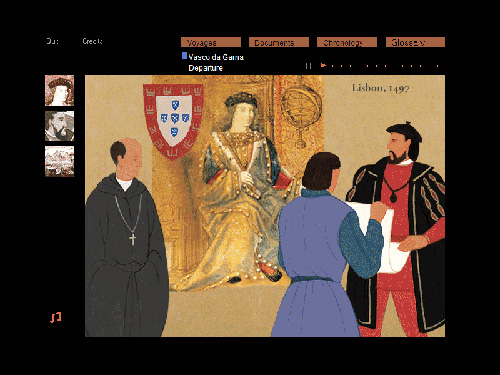 Fig. 6: The departure of Vasco da Gama on CD ROM 'Navegar',
Comissao Nacional para a Comemoraçao dos Descobrimentos Portugueses
/ Oda Édition / RMN, 1998.
Fig. 6: The departure of Vasco da Gama on CD ROM 'Navegar',
Comissao Nacional para a Comemoraçao dos Descobrimentos Portugueses
/ Oda Édition / RMN, 1998.
Another example is the CD ROM 'Navegar' (1998) of the Portugal Expo'98 which shows how a historical character like Vasco da Gama reports about the expedition in his own words. Cartoons are used to connect the artefacts and the informations about the voyage to various scenes. Indeed, the user will feel an immediate bonding with the mariner, this proximity can also be problematic though, as the prejudices of the catholic conqueror towards the natives is emphasized. 'Navegar' gives only one perspective of the story and his point of view seems to be favouring colonialism too strongly. A critical objective perspective is thus missing.
Interactive Narration
It seems that the CD ROM 'Le Livre de Lulu', produced 1995 by Romain Victor-Pujebet and published by Organa, is more of an audio book than a CD ROM. The author himself is lecturing about the adventures of princess Lulu and Mnémo, the robot from planet Solus. But behind this simple concept of words and images a lot of animations and gimmicks have been hidden. By exploring all of these the story itself is slowed down in such a manner that there is a danger that the user is going to loose the thread of the story. The interactive attractions start with a competition – or what might more acurately be called a rivalry between the story and the interactions itself. By creating a hidden mixture of several media and materials, Lulu and Mnémo will require the continous attention of the viewer for quite a long time span. Thus it appeals strongly to romantic grown-ups or young girls and boys.
In "The inquisition of Johannes Gruen of Kauffbueren. A historic criminal case", (whic is part of the CD ROM 'Museum Schloss Kyburg'), the user is allowed to compare the historic court documents of 1725 ('Malefizbook') while viewing a movie-like reconstruction of the event. This gives the user an overview in the proceeds surrounding the search for proof and truth, namely the practice of torture. But then again the film is interrupted by questions like "Would you set him free?" or "What do you think? Is he guilty or not guilty?" allowing the viewer to interact with the proceedings by trying to answer these questions himself.
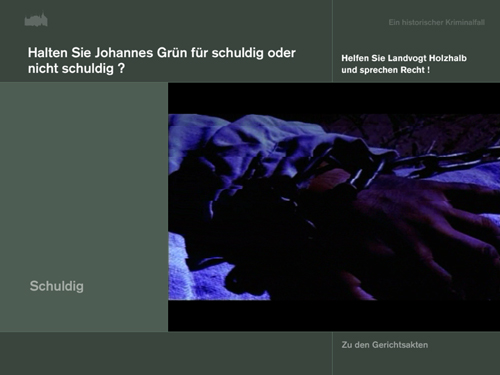 Fig. 7: The inquisition
of Johannes Gruen of Kauffbueren. A historic criminal case, on CD ROM 'Museum
Schloss Kyburg', Verein Schloss Kyburg / Transfusionen, 2004.
Fig. 7: The inquisition
of Johannes Gruen of Kauffbueren. A historic criminal case, on CD ROM 'Museum
Schloss Kyburg', Verein Schloss Kyburg / Transfusionen, 2004.
These interregnums in the process of finding the truth are absolute necessary. They break the flow of the story and the visitor himself is called onto the Bench. At these points of interaction visitors often raise a discussion in the museum and start to talk about their personal opinions. The film and the protocol is enhanced by a commentary about the Swiss judiciary system of the 18th century and an analysis of the whole situation given by a a present day judge, furthermore an introduction is given into the abuse of torture today by explaining and linking to the Universal Declaration of Human Rights and the UN Convention against Torture. By combining different media and strategies this subject is thus transferred into the present time of the museum and the classroom.
The 'Vienna Walk Demo', released in 1998, is a prototype of an interactive film on DVD-ROM, produced by Science Wonder Productions. It gives us a futuristic vision of real interactivity and intelligent knowledge transfer in the field of cultural heritage-tourism-ecommerce. Originally presented on the 1999 Museum and the Web conference in New Orleans 'Vienna Walk' has the distinction of being one of the first DVD-ROMs on MPEG2 with a total length of more than 4 hours (Kraemer 2001). The theme is that of a virtual institution planning to get an encyclopedia of the values (economic, cultural and energy) of the city of Vienna. Three agents (Tatjana, Pauline and Tomo) have to fulfill their missions. They have 24 hours each and they lead the viewer – their accomplice in the real world – to specific locations in Vienna. Through interactive crossings the user can leave the main story by following a skateboarding avatar to meet other people or follow a sub-line of the story. So the user can go shopping with Tatjana and purchase actual goods on-line or have a look at the current program of the opera as well as buy tickets for the same during the viewing of the CD ROM.
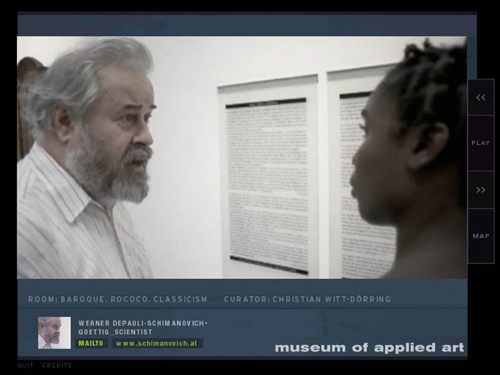 Fig. 8: Pauline speaking to W. Schimanovich on DVD ROM
'Vienna Walk Demo', Science Wonder Productions, 1998.
Fig. 8: Pauline speaking to W. Schimanovich on DVD ROM
'Vienna Walk Demo', Science Wonder Productions, 1998.
Pauline, who is responsible for art and culture, is meanwhile strolling in the Museum of applied Arts. When she meets another visitor the user can start a discussion about the purpose of art by clicking on him. And if the users do not agree with the statements, they can send the virtual visitor an email. By sending a real email to someone in the film without actually leaving the film, the gap between reality and virtuality is thus overcome. In this way 'Vienna Walk' has shown that the relationship between navigation and content has significantly changed. Intelligent navigation leads us through the world of facts and is part of the content at the same time.
Dramaturgy
If the most successful way to transfer informations is the "creation of a confidential relation" as the sociologist Treinen (1996, 120) has said – then the primary objective has become to define strategies for the identification with the content by using the visitor's own experiences, preferences and curiosity. To capture the visitor's "feeling of solidarity" (Mothes 2001, 78) by empathy – visualized in a sensitive and inspiring dramaturgy – will be the key to create polyperspective readings and hyperlinked narrative structures. Or in the words of Murray (2000): "Multiform Story" and "Multicharacter environments." But the dramaturgy of theatre plays (Laurel 2000), movies and radio plays (Mikunda 2002) can't be transferred that easily and still meet the needs of hypermedia (Kraemer 2007). Traditional narratives use a linear structure, pushing a single storyline, while hypermedia applications need a network of hyperlinked ministories, targeted to different user-groups and versatile enough to be used in different fields of application. Furthermore the narratives in hypermedia applications uses a type of language combining the verbal rhetoric with the visual rhetoric to create a "cognitive design" (Khazaeli 2005).
To unify content, navigation and design it is not only necessary for the creator to realise a sort of 'visual intelligence', but also demands hypermedia competence of the user. These competences are visualized perfectly in Dieter Kiesslings masterpiece 'continue' (Kraemer 2001). In this interactive binary drama from 1997 the user is given the freedom to either "quit" (white) or "continue" (black). If you choose "continue" the two fields initially presented change to 4 fields, than 8, 16, 32, 64, 128, 256 fields and so on. And after a while – in one continous flow – the screen ends up being full with black and white dots.
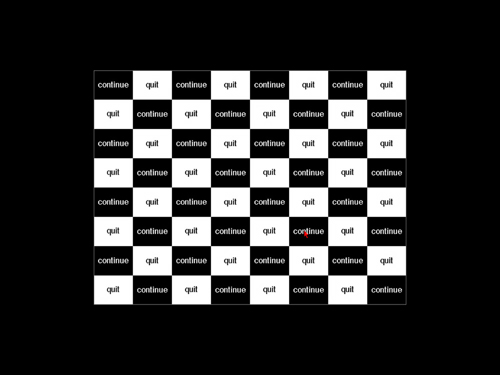 Fig.
9: Dieter Kiessling's masterpiece 'continue' on 'Artintact 4', ZKM Karlsruhe,
1997
Fig.
9: Dieter Kiessling's masterpiece 'continue' on 'Artintact 4', ZKM Karlsruhe,
1997
This approach to free will is in effect killing the presentation. The longer you go on the more accidental the interactions becomes and the interface ceases to be usable. The user ends up being overwhelmed by this torrent of information and thus comes to realise the problems inherent in a system like this. But Interactivity – the multiple choices of digital one ways streets – can also be an activity of creative action, that encompasses both the intention to participate in creativity and in confrontation. The first signifies a joyful collaboration, the second a clash with the system. Real interactivity thus grows out of the actuality of an action. It is productivity that leads to the creation of reality and the meaning of perception. Pacing, simplicity and a good story with a choice for life (continue) or death (quit); all this is found in pure essence on Kiesslings masterpiece.
The best navigation is content in itself and not only a simplified duplicating of the content. Thus information architecture should create different levels of context and animate the user to construct meaning autonomously. Thus the readability is directly dependent on the experiences and personal needs of the user him/herself. Timeless questions need contemporary – in our case hypermedial – answers. Just telling interactive stories is not enough. In a film each individual sequence is responsable for the rhythm of the story and the dynamics of the actions. The eye of the viewer easily ends up being bored if there is no change of scenes and no variety to the shots. To subdue the visual ennui a diversified and eventful dramaturgy is necessary. The real challenge of such a dramaturgy is going to be to find a way to design motivating modules of content with an overall visual and acoustic concept. But how can we catch the attention of the user? How can we decelerate the dynamics of the user attitudes? How can we simplify the complexity of the informations? Dramaturgy in a film is the correct application of pacing, of rapid pulse beats and then to pause for a moment. This means that the story is not only used as a narrative but also as a way of design, and furthermore also that the story serves as a means for the recipient to identify with the content. To transfer this strategy into the liquid architecture of hypermedia means to understand the principle of simultaneity in the dissimultaneity. Larry Friedlander has shown us that the problems encountered when trying to communicate information about art are not art-specific, but essential for the common transfer of knowledge. "How can we analyze the structure of such a hybrid experience, and how can we better design this kind of complex space? How do we integrate media rich environments with people-rich ones and make them human, warm and conducive to learning? How do we organize these experiences for the user so they can make sense of them without robbing them of their inherently rich and spontaneous qualities?" (Friedlander 1999). As such it is important to learn how to accelerate and decelerate the flow of information at the right moment, as well as learning to understand how to lead the user with a storyline and in equal measure through a navigational design. Thus by following the philosophy of "Festina Lente" – and always remaining considerate of the needs of the user – it should be possible to create a work which is at the same time complex yet still intuitive.
Acknowledgments
I am very grateful to Prof. Dr. Bernd Nicolai for the travel grants and Raphael Huerzeler for his translation assistance.
References
Bode, S. (1995). Multimedia in Museen – weder Koenigsweg noch Guillotine. In K. Fast (Ed.) Handbuch der museumspaedagogischen Ansaetze. Opladen: Leske und Budrich, 335-362.
Emerson, R. W. (2006). Nature. In: L. Buell (Ed.) The American Transcendentalists. New York: The Modern Library Classics [Boston: James Munroe, 1836], 31-67.
Friedlaeder, L. (1999): Keeping the Virtual Social. In D. Bearman & J. Trant (Eds.) Museums and the Web 99. Proceedings. CD ROM. Archives & Museum Informatics, 1999. http://www.archimuse.com/mw99/papers/friedlander/friedlander.html (consulted July 25, 2007).
Genette, G. (1994). Die Erzaehlung. Munich: Fink/UTB.
Khazaeli, C. D. (2005). Systemisches Design. Intelligente Oberflaechen fuer Information und Interaktion. Reinbek bei Hamburg: Rowohlt.
Kraemer, H. (2007). Art is redeemed, mystery is gone: the documentation of contemporary art. In S. Kenderdine & F. Cameron (Eds.) Theorising Futures for the Past. Cultural Heritage and Digital Media. Cambridge MA: MIT Press, 193-222.
Kraemer, H. (2006). Museums are storytellers! New perspectives of education and hypermedia. In The New Media Consortium & CASE Western University & Cleveland Museum of Art (Eds.) Understanding the New Dynamic: Art, Technology, and the Mind. Readings. Cleveland, Ohio: 165-172.
Kraemer, H. & N. Kanter (2004). Dramaturgie – Navigation – Interaktivitaet: Komponenten gelungener Kommunikation mittels Hypermedia. In Schoeppinger Forum der Kunstvermittlung (Eds.) Versuche im Zwischenraum. Experimentelle Kunstvermittlung im digitalen Zeitalter. Schoeppingen: Verlag Stiftung Kuenstlerdorf Schoeppingen, 36-57.
Kraemer, H. & K. Jaggi (2003) The Virtual Transfer Musee Suisse. Digital Technology reshaping the strategy of the Swiss National Museum. In: ICHIM03 l'École du Louvre, Paris, 8.-12. September 2003, Conference Proceedings on CD ROM. Available http://www.archimuse.com/publishing/ichim03/014C.pdf
Kraemer, H. (2001) CD ROM und digitaler Film – Interaktivitaet als Strategien der Wissensvermittlung. In Gemmeke, C. & H. John & H. Kraemer (Eds.) Euphorie digital? Aspekte der Wissensvermittlung in Kunst, Kultur und Technologie. Bielefeld: Transcript Verlag, 199-228.
Laurel, B. (2000). Computers as Theatre. Reading MA et al.: Addison Wesley Longman [1991, 8/2000].
Maeda, J. (2006). The Laws of Simplicity. Cambridge, MA.: The MIT Press.
Marable, B. (2004) Experience, Learning And Research: Coordinating The Multiple Roles Of On-Line Exhibitions. In D. Bearman & J. Trant (Eds.) Museums and the Web 2004: Proceedings. Archives & Museum Informatics, 2004. http://www.archimuse.com/mw2004/papers/marable/marable.html (consulted July 25, 2007).
Marable, Bart (1999): Once upon a Time: Using New Narratives in Educational Web Sites. In D. Bearman & J. Trant (Eds.) Museums and the Web 1999: Proceedings . Archives & Museum Informatics, 1999. http://www.archimuse.com/mw99/papers/marable/marable.html (consulted July 25, 2007).
Meadows, M. S. (2006). Pause & Effect. The art of interactive narrative. Indianapolis: New Riders [2002, 7/2006].
Mikos, L. (2003). Film- und Fernsehanalyse. Konstanz: UVK.
Mikunda, C. (2002). Kino spueren. Strategien der emotionalen Filmgestaltung. Wien: WUV Universitaetsverlag.
Mothes, U. (2001). Dramaturgie fuer Spielfilm, Hoerspiel und Feature. Konstanz: UVK.
Murray, J. H. (2000). Hamlet on the Holodeck. The Futures of Narrative in Cyberspace. Cambridge, MA.: The MIT Press, [1997, 3/2000].
Schoepf, C. & G. Stocker (Eds.) (2006). Simplicity – the art of complexity. Ars Electronica, Ostfildern: Hatje Cantz.
Treinen, H. (1996). Das Museum als kultureller Vermittlungsort in der Erlebnisgesellschaft. In Landschaftsverband Rheinland (Ed.): Vom Elfenbeinturm zur Fußgaengerzone. Opladen: Leske und Budrich, 111-121.
Cite as:
Kraemer, H., Simplicity, Slowness and Good Old Stories as Strategies and Perspectives of Design in Hypermedia and Media, in International Cultural Heritage Informatics Meeting (ICHIM07): Proceedings, J. Trant and D. Bearman (eds). Toronto: Archives & Museum Informatics. 2007. Published October 24, 2007 at http://www.archimuse.com/ichim07/papers/kraemer/kraemer.html